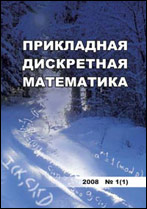|
Discrete Models for Real Processes
Discrete stochastic simulation of the electrons and holes recombination in the 2D and 3D inhomogeneous semiconductor
K. K. Sabelfeld, A. E. Kireeva
Institute of Computational Mathematics and Mathematical Geophysics SB RAS, Novosibirsk, Russia
Abstract:
Stochastic models of electron-hole recombination in 2D and 3D inhomogeneous semiconductors based on a discrete cellular automata approach are presented in the paper. These models are derived from a Monte Carlo algorithm based on spatially inhomogeneous nonlinear Smoluchowski equations with the random initial distribution density used to simulate the annihilation of spatially separate electrons and holes in a disordered semiconductor characterized by the heterogeneous properties of the material. Recombination kinetics in different regimes such as a pure diffusion, diffusion in vicinity of tunneling and diffusion in the presence of recombination centers are investigated by a cellular automata simulation. Statistical characteristics of the recombination process (particle concentrations and the radiative intensity) obtained by the cellular automaton models are compared with the theoretically known asymptotics derived for a pure diffusion case. The results obtained for a two-dimensional domain correspond to the theoretical asymptotics, whereas in three-dimensional case, they differ from the exact asymptotics. It is found out by simulations that a spatial electron and hole separation (segregation) occurs under certain conditions on the diffusion and tunneling rates. The electron-hole spatial segregation in 2D and 3D semiconductors is analyzed by using the probability density of the electron-hole separation. In addition, the execution time of the codes implementing the cellular automaton model of the recombination in 2D and 3D semiconductors is studied in dependence on the number of simulated electron-hole pairs and the size of the semiconductor domain. It is shown that the execution time for semiconductors of dimension d is proportional to a polynomial of order d.
Keywords:
recombination, semiconductor, diffusion, tunnelling, stochastic simulation, cellular automata.
Citation:
K. K. Sabelfeld, A. E. Kireeva, “Discrete stochastic simulation of the electrons and holes recombination in the 2D and 3D inhomogeneous semiconductor”, Prikl. Diskr. Mat., 2016, no. 4(34), 110–127
Linking options:
https://www.mathnet.ru/eng/pdm565 https://www.mathnet.ru/eng/pdm/y2016/i4/p110
|

| Statistics & downloads: |
| Abstract page: | 238 | | Full-text PDF : | 89 | | References: | 32 |
|




 Contact us:
Contact us: Terms of Use
Terms of Use
 Registration to the website
Registration to the website Logotypes
Logotypes








 Citation in format
Citation in format 